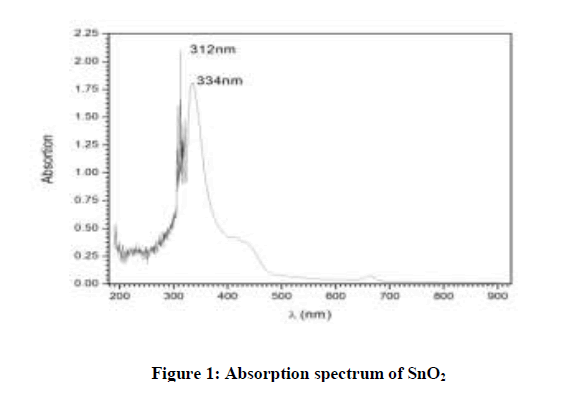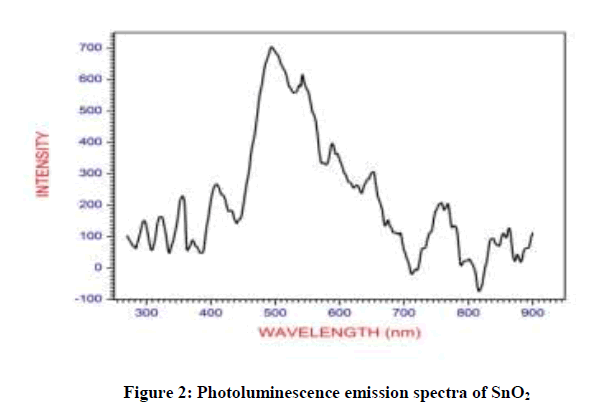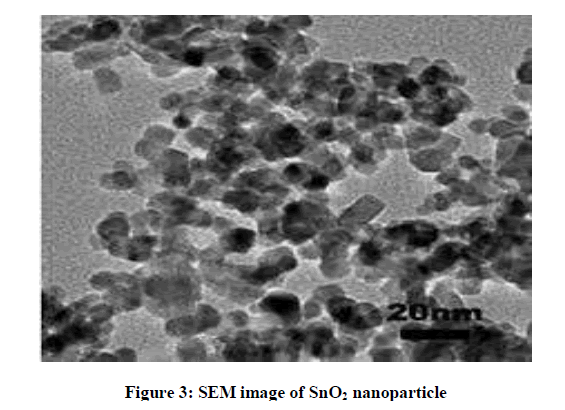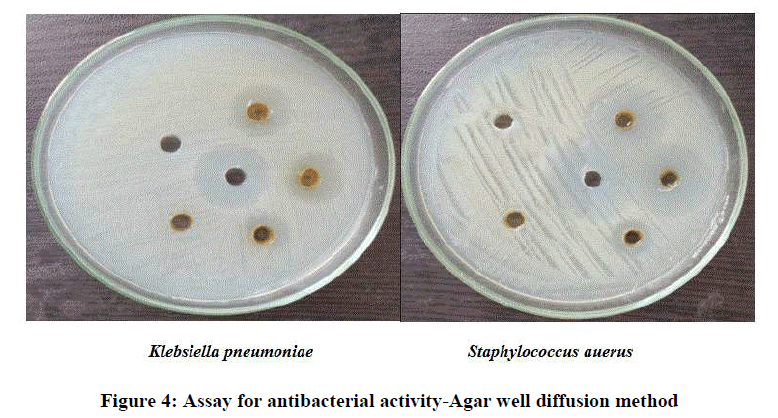Research Article - Der Pharma Chemica ( 2018) Volume 10, Issue 2
Synthesis and Characterization of Tin Oxide Nanoparticles Using Plant Extract
Merlin M1*, Chitra S1 and Nalini Jayanthi N2
1Department of Chemistry, Jeppiaar Engineering College, Chennai, India
2Department of Physics, KCG college of Technology, Chennai, India
Abstract
In recent years SnO2 has attracted a lot of interest because of its outstanding electrical, optical and electro-chemical properties and these properties has enabled the application of SnO2 in solar cells, catalytic support materials, transparent electrodes and solid state chemical sensors. Very recently, nano-crystalline SnO2 has gained prominence in technological field due to its interesting electrical and optical properties arising out of large surface-to-volume ratio, quantum confinement effect. The synthesis of metal oxide nanoparticles using plant extract is an alternative method to other chemical and physical methods which has environmental toxicity or biological hazards. Hence it is a challenge to find cost effective, non-toxic natural metal oxide nanoparticles and to synthesize them. Plant extracts will act both as reducing and capping agents in the synthesis of nano particle. In the present study SnO2 nanoparticles were synthesized by using ethanolic extract of the plant Stevia rebaudiana. The tin oxide nanoparticles thus formed was characterized by UV, PL and SEM. The antibacterial activities of SnO2 nanoparticles were studied by using Klebsiella pneumoniae and Staphylococcus aureus.
Keywords
Green synthesis, Metal oxide nanoparticles, Biological activities, Stevia rebaudiana, Klebsilla pneumoniae, Staphylococcus aureus
Introduction
Metals and metal oxide nanoparticles shows a great demand in the chemical, electronic and pharmaceutical industries [1,2]. Among the nano metal oxides, tin(IV) oxide plays a very important role in the field of gas sensing and catalysis and as a transparent conducting oxide [3]. The properties such as high degree of transparency in the visible spectrum, strong physical and chemical interactions with adsorbed species, low operating temperature and strong thermal stability in air (up to 500°C) makes SnO2 as a promising material. The varied application of SnO2 nanoparticles is due to its bulk structure, surface and interface properties. Many synthetic methods are available for synthesizing nano tin(IV) oxide. But the green synthetic approach using plant extracts attracted the researchers due to their simplicity and ecofriendly approach [4]. It is cost effective and therefore can be used as an economic and viable alternative for the large scale production of metal oxide nanoparticles. The rate of nano synthesis or the stability of the product depends on the reducing agents, capping agents used during the synthesis of nanomaterials. But in the green synthesis of nanomaterials, the alkaloids, flavones, terpenes, amino acids and carbohydrates present in the plant materials act as the reducing agents and capping agents which plays a major role on the surface morphology and size of the metals [5].
The plant used for the present study was Stevia rebaudiana which is the best source of natural sweetener. It belongs to the Asteraceae family and it is commonly referred to as Honey leaf, Candy leaf and Sweet leaf [6,7]. It is rich in terpenes and flavonoids. The photochemical present in S. rebaudiana are austroinullin, β-carotene, dulcoside, nilacin, rebaudi oxides, riboflavin, steviol and stevioside [8]. The synthesis of metal oxide nanoparticles using plant extract is an alternative method to other chemical and physical methods which has environmental toxicity or biological hazards methods [9-13].
There is a continuous and urgent need to discover new antimicrobial compounds with diverse chemical structures and novel mechanisms of action due to an alarming increase in the incidence of new and emerging infectious diseases and development of resistance to the antibiotics in current clinical use [14]. The traditional and folklore medicines play an important role in health service around the globe, about three quarter of the world’s population relies on plants and plant extracts for health care. Several plants have been used in folklore medicine [14]. The traditional design of novel drugs from traditional medicine offers new prospects in modern health care [15]. The present investigation on the antibacterial activity of SnO2 nanoparticle in the ethanolic extract of the plant S. rebaudiana; To determine the effectiveness of medicine against Gram-positive and Gram-negative bacteria, certainly shall help to renovate the value of aged old traditional medicine.
Materials and Methods
Plant material
S. rebaudiana leaves were obtained from Thekkadi, Kerala. The leaves were washed with sterile water, dried in shade, finely powdered & stored in air tight bottles.
Preparation of plant extract
The leaves of S. rebaudiana plant were dried at room temperature and powdered well. Then 10 g of dried powder was mixed with 100 ml of ethanol in a conical flask and the mixture was heated at 60°C. It was incubated at room temperature for 48 at 180 rpm in an orbital shaker. It was filtered by using Whatman filter paper No.1 and the dark green color extract was obtained. This ethanolic extract was used as stock solution for the study.
Synthesis of tin oxide nanoparticles
10 ml of ethanolic extract of S. rebaudiana was mixed with 90 ml of 1 mM tin oxide aqueous solution in 250 ml conical flask. The reaction mixture was heated at 80°C for two h. The greenish yellow coloured solution changed into pale yellow which showed the formation of tin oxide nanoparticles.
Characterization
The SnO2 nano particles synthesized by S. rebaudiana leaves extract is subjected to UV and PL studies. The size, shape and morphology of the nano particle are confirmed by Scanning Electron Microscope (SEM) analysis. Antimicrobial activities of the synthesized tin (IV) oxide nanoparticles were performed against both Gram-negative (K. pneumoniae) and Gram-positive (S. aureus) bacteria.
Results and Discussion
UV-Visible NIR studies
Above figure shows the results of optical absorption spectra of SnO2 nanomaterials in UV-Vis-NIR region (Figure 1). It can be seen that SnO2 nano particles shows absorption in the UV light region whereas it is transparent in the visible region. The spectrum shows maximum absorption around 334 nm and the estimated band gap was 3.71 eV. This value is related to the formation of nanostructures of SnO2. This value shows a good agreement with the values presented by other workers [16-18].
Photo luminescence studies
Figure 2 shows the photoluminescence emission spectra of SnO2 nanoparticles at 334 nm excitation. SnO2 nanoparticles exhibit emission at 510 nm. The emission maximum of 510 nm is lower than the band gap of the SnO2 bulk; this peak can be attributed to the contribution of oxygen vacancies and defect in the SnO2 nanoparticles [19]. It has been reported that this photo luminescent emission in the region of 425-540 nm might be associated with the transition of electrons from oxygen vacancy level to the photo-excited holes in the valence band [20].
Figure 3 shows the presence of homogeneous and well-dispersed spherical nanoparticles and some of them partially aggregated in the form of irregular shaped tin oxide nanoparticles. The SEM micrograph enabled the computation of the particle size and its reveals the presence of SnO2 nanoparticles which ranges from 20-30 nm.
Assay for antibacterial activity-Agar well diffusion method (Figure 4)
Preparation of inoculum
Stock cultures were maintained at 4°C on slant of nutrient agar. Active cultures for experiments were prepared by transferring a loop full of cells from the stock cultures to test tubes of nutrient broth for bacteria that were incubated at 24 h at 37°C. The Assay was performed by agar disc diffusion method.
Antibacterial activity
Antibacterial activity of sample was determined by well diffusion method on Muller Hinton agar (MHA) medium. The Muller Hinton Agar medium was weighed as 3.8 g and dissolved in 100 ml of distilled water and add 1 g of agar. Then the medium is kept for sterilization. After sterilization the media was poured in to sterile petriplates and were allowed to solidify for 1 h. After the medium was solidified, the inoculums were spread on the solid plates with sterile swab moistened with the bacterial suspension. Wells were cut on these plates and loaded with 20 μl sample of respective concentrations (1000, 500, 250 and 125 μg), negative control 20 μl of Dimethyl Sulfoxide (DMSO) and positive control 10 μl (10 μg) streptomycin. These plates were incubated for 24 h at 37°. Then the microbial growth (K. pneumoniae and S. aureus) was determined by measuring the diameter of zone of inhibition (Table 1).
| Microorganisms | Zone of inhibition in mm | |||||
|---|---|---|---|---|---|---|
| 1000 µg | 500 µg | 250 µg | 125 µg | DMSO | Streptomycin (10 µg) | |
| Klebsilla pneumoniae | ||||||
| Liquid | 20 | 17 | 13 | - | - | 22 |
| Staphylococcus aureus | ||||||
| Liquid | 22 | 19 | 11 | - | - | 23 |
Table 1: Determination of antibacterial activity by measuring the diameter of zone of inhibition
The present study reveals that the SnO2 nanoparticle synthesized by using ethanolic extract of plant S. rebaudiana has antibacterial activity against the common pathogens like S. aureus and K. pneumoniae. SnO2 nanoparticles shows higher inhibitory effect on Gram-positive bacteria S. aureus compared to Gram-negative bacteria K. pneumoniae. SnO2 nanoparticles showed highest maximum activity 22 mm, 19 mm and 11 mm at concentration 1000, 500 and 250 μg respectively against S. aureus. For the respective concentration the zone of inhibition was found to be 20, 17 and 13 mm against K. pneumoniae. S. aureus has shown the maximum zone of inhibition of 22 mm at the highest concentration of 1000 μg. As the concentration of the SnO2 nanoparticles decreases, the antibacterial activity also decreases against both Gram-positive and Gram-negative bacteria.
Conclusion
This paper explained the green synthesis of SnO2 nanoparticles. The formation of nanoparticles of SnO2 was confirmed by SEM micrograph and UV-Vis-NIR studies, which showed the maximum absorption around 334 nm with the estimated band gap 3.71 eV. Photo Luminescence studies showed the emission at 510 nm which can be attributed to the contribution of oxygen vacancies and defect in the SnO2 nanoparticles. Antibacterial activity studies showed the higher inhibitory effect on gram positive bacteria S. aureus compared to Gram-negative bacteria K. pneumoniae. The absorption and emission spectra of SnO2 nanoparticles synthesized by this method revealed that this material can also be used as solar energy absorbing materials. Thus the synthesis of SnO2 nanoparticles using the leaf extract of plant S. rebaudiana is very simple, cost effective and eco-friendly process. This process can also be used for synthesis of other metal nanoparticles.
References
- R. Narayanan, Green Chem. Lett. Rev., 2012, 5(4), 707-725.
- S. Hariprasad, G. Susheela Bai, J. Santhoshkumar, C.H. Madhu, D. Sravani, Int. J. ChemTech Res., 2016, 9(2), 98-105.
- F. Gu, S.F. Wang, M.K. Lu, G.J. Zhou, D. Xu, D.R. Yuan, J. Phy. Chem. B., 2004, 108, 8119-8123.
- S.R. Bonde, D.P. Rathod, A.P. Ingle, R.B. Ade, A.K. Gade, M.K. Rai, Nano Sci Methods., 2012, 1(1), 25-36.
- K.S. Kavitha, S. Baker, D. Rakshith, H.U. Kavitha, B.P. Harini, S. Satish, Int. Res. J. Biolog. Sci., 2013, 2(6), 66-70.
- A.D. Kinghorn, D.D. Soejarto, Current status of stevioside as a sweetening agent for human use. In: H. Wagner, H. Hikino, N.R. Farnsworth (editorss.), Economic and medicinal plant research, Academic Press, London, UK; 1985.
- B. Crammer, R. Ikan, Chem. Br., 1986, 22, 915-917.
- G. Sangeetha, S. Rajeshwari, R. Venckatesh, Progress in Natural Science: Materials International, 2012, 22(6), 693-700.
- P. Kamaraj, R. Vennila, M. Arthanareeswari, S. Devikala, World Journal of Pharmacy and Pharmaceutical Sciences., 2014, 3(9), 382-388.
- J. Foba-Tendo, I. Ngenefeme, J. Namanga Eko, D. Yufanyi Mbom, D. Ndinteh Tantoh, W.M. Krause, A. Rui, Open Journal of Composite Materials., 2013, 3, 30-37.
- M. Mahdavi, F. Namvar, M.B. Ahmad, R. Mohamad, Molecules., 2013, 18, 5954-5964.
- C. Vidya, S. Hirematha, M.N. Chandraprabhab, M.A. Lourdu Antonyraja, I.V. Gopala, A. Jaina, K. Bansala, Int. J. Curr. Eng. Technol., 2013, 118-120.
- J. Bauer, R. Rojas, B. Bustamante, J. Ethnopharmacol., 2003, 88, 199-204.
- Devasenan, N. Hajara Beevi, S.S. Jayanthi, Int. J. ChemTech Res., 2016, 9(4), 725-730.
- M. Premanathan, S. Rajendran, N.A. Yamamoto, Indian J. Med. Res., 2000, 112, 73-77.
- P. Venkateswara Reddy, S. Venkatramana Reddy, B. Sankara Reddy, Int. J. ChemTech Res., 2014, 7(3), 1474-1480.
- S. Gnanam, V. Rajendran, Dig. J. Nanomater. Biostruct., 2010, 5(3), 699-704.
- F. Gu, S.F. Wang, C.F. Song, M.K. L€u, Y.X. Qi, G.J. Zhou, D. Xu, D.R. Yuan, Chem. Phys. Lett., 2003, 72, 451-454.
- K. Ravichandran, K. Thirumurugan, N. Jabena Begum, S. Snega, Superlattices Microstruct., 2013, 60, 327.
- M. Saravanakumar, S. Agilan, N. Muthukumarasamy, V. Rukkumani, A. Marusamy, P. Uma maheshwari, A. Ranjitha, Int. J. ChemTech Res., 2014, 6(14), 5429-5432.







